Pandemic, like a good war, is first and foremost a business opportunity. Like every war profiteer, Elsevier caters all sides. Including the violent covidiots and antivaxxers, whom Elsevier supplies with peer-reviewed scare-mongering while peddling cigarettes as COVID-19 cures, with a side serving of environmental pollution with toxic chemicals and radiation as others benefits for your health. Most of it concetrated in one journal, Toxicology Reports. But even for Elsevier’s standards, this choice of the editors is a new low (but maybe not for MDPI).
Smut Clyde wrote a long expose, and I’m afraid you will want to read it now.
Mithridates, he died old
By Smut Clyde
It is that time again when we credit the RetractionWatch bloggers, for this post draws heavily on their coverage of some recent retractions (along with the associated PubPeer threads). I should also credit a blogpost by Sam Klein, which you should read if you have not already done so; and major contributions by Sam and by an anonymous colleague.
Stolen from Oglaf
 (1). Persons unknown at MDPI journal Vaccines had been burning Incense of Bad Decisions, and approved the publication of a sublimation of antivax ignorance and mendacity:
(1). Persons unknown at MDPI journal Vaccines had been burning Incense of Bad Decisions, and approved the publication of a sublimation of antivax ignorance and mendacity:
Harald Walach, Rainer J. Klement, Wouter Aukema The Safety of COVID-19 Vaccinations—We Should Rethink the Policy Vaccines (2021) doi: 10.3390/vaccines9070693
The links explain why the paper was unmitigated crap, sparing me the need to delve into detail. Every principled member of the Board of Editors resigned in protest, and the piece was swiftly Expression-of-Concerned, and then retracted, despite Harald Walach’s spirited defense.
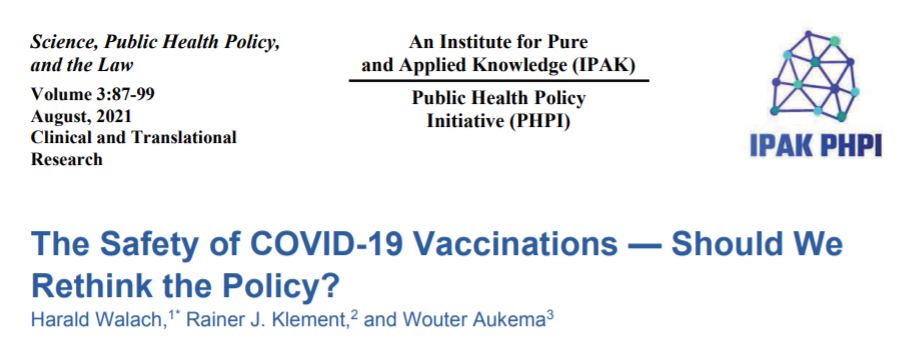
Don’t grieve for the piece: it had already been rehoused in a Home for Distressed Antivaxxery run by “Institute of Pure and Applied Knowledge” (which is James Lyons-Weiler, failed scamference impresario, who has first-hand experience of retraction). And the ex-Editors rejoined the journal… which might be premature, unless the systems failure or corruption that allowed the paper’s acceptance has been identified and remedied. Meanwhile Poznan University of Medical Sciences severed its association with Walach, and Pepijn van Erp looked at the other two authors.
(2). Someone must have told Walach that “this is the stupidest paper imaginable”, to which he replied “Hold my beer!” – for he is also first author of
Harald Walach , Ronald Weikl , Juliane Prentice , Andreas Diemer , Helmut Traindl , Anna Kappes, Stefan Hockertz Experimental Assessment of Carbon Dioxide Content in Inhaled Air With or Without Face Masks in Healthy Children: A Randomized Clinical Trial JAMA Pediatrics (2021) doi: 10.1001/jamapediatrics.2021.2659
Which proved that wearing masks causes hypoxia and hypercapnia (Walach et al. ignored most of the data they’d collected, perhaps because they clashed with the desired conclusions). The paper contained the term “COVID-19” which causes hypoxia and hypercapnia and destroys critical faculties in the brains of reviewers, and was thus accepted by JAMA (Pediatrics). An Expression of Concern, and the authors’ spirited defense, and Retraction swiftly ensued, though the damage to JAMA’s reputation lingers on.
All this leads naturally on to…
(3).
Jessica Rose, Peter A. McCullough A Report on Myocarditis Adverse Events in the U.S. Vaccine Adverse Events Reporting System (VAERS) in Association with COVID-19 Injectable Biological Products Current Problems in Cardiology (2021) doi: 10.1016/j.cpcardiol.2021.101011
The first author, Jessica Rose, is a polemicist affiliated to James Lyons-Weiler IPAK in its incarnation as “Public Health Policy Initiative”. Peter McCullough is affiliated to his own fund-raising appeal. Regrettably, he had claimed an affiliation to Baylor Healthcare when the paper first appeared in Current Problems in Cardiology, breaching Baylor’s restraining order.
It is tempting to speculate that the involvement of lawyers is why the report’s disappearance and then retraction were so rapid and explanation-free, but another possibility is that as an Invited Paper it simply hadn’t been reviewed in the first place. As is the custom, re-publication in the IPAK journal-shaped garbage scow followed – though minus McCullough’s name.
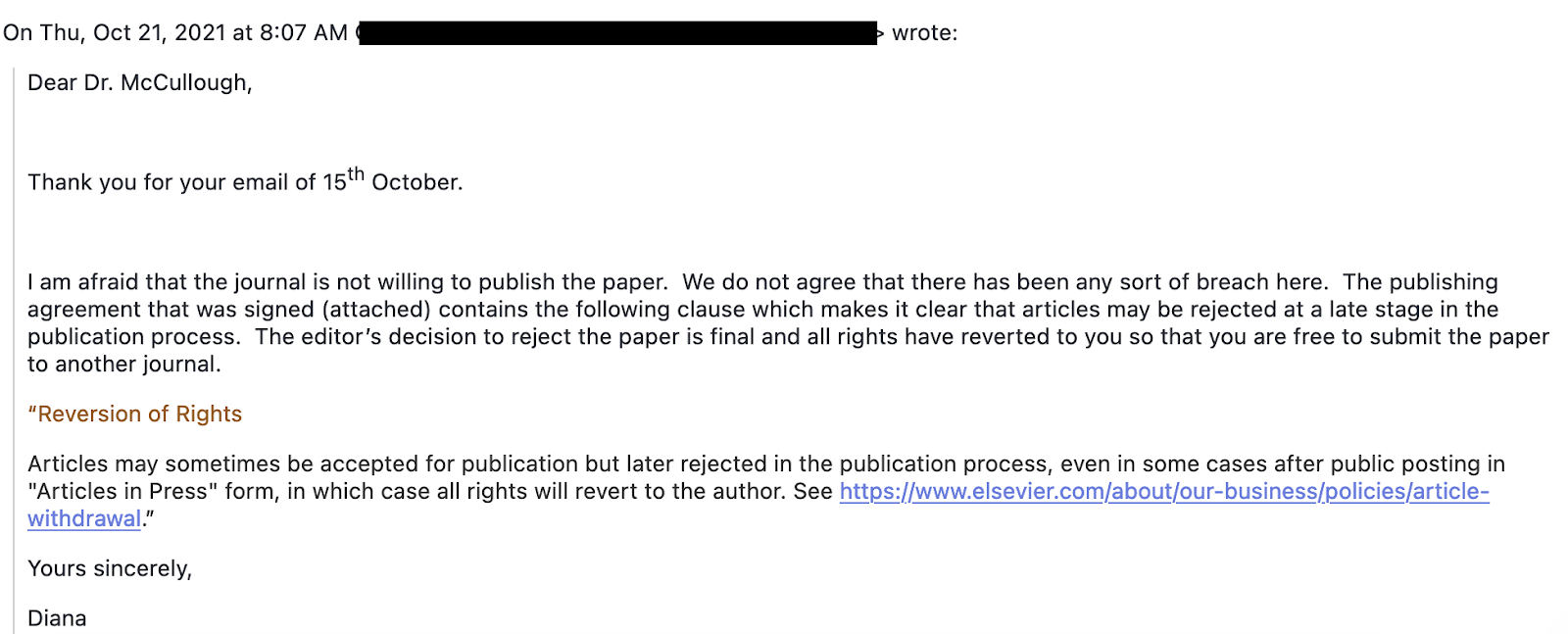
(4).
Ronald N. Kostoff , Daniela Calina , Darja Kanduc , Michael B. Briggs , Panayiotis Vlachoyiannopoulos , Andrey A. Svistunov , Aristidis Tsatsakis “Why are we vaccinating children against COVID-19? Toxicology Reports (2021) doi: 10.1016/j.toxrep.2021.08.010
This one has not been retracted, despite its low signal-to-noise ratio, but RW ventured outside their wheelhouse to post about it anyway, carrying the first author’s spirited defense (Kostoff also weighed in on Rose & McCullough). Meanwhile the last author Aristidis Tsatsakis maintained a dignified silence, as befits the Editor-in-Chief of Toxicology Reports, where the paper was published. Retraction is not expected soon.
Tsatsakis, King of Toxicology Reports
The paper was at least the subject of an Erratum, bringing it under RW’s ambit, or within its aegis, or something like that. The original statement that the manuscript’s processing had been overseen by A. Tsatsakis is no longer operative, and the role of Stunt Editor – responsible for peer review and acceptance – shifted to his regular collaborator Dr Konstantinos Poulas.
This seems to happen a lot in the Toxicology Reports office, creating a mental image of a chaotic climate where passers-by grab whatever manuscript is on top of the pile and take it back to their cubicles to handle, while the Editor-in-Chief is busy writing further manuscripts for future publication in Toxicology Reports. and is too preoccupied to keep a record of who handled which papers. Or perhaps the credit for being Handling Editor is assigned by default to Tsatsakis for all manuscripts, as a kind of Droit du Seigneur.
For instance,
Daniela Calina, Thomas Hartung, Ileana Mardare, Mihaela Mitroi, Konstantinos Poulas, Aristidis Tsatsakis, Ion Rogoveanu, Anca Oana Docea COVID-19 pandemic and alcohol consumption: Impacts and interconnections Toxicology Reports (2021) doi: 10.1016/j.toxrep.2021.03.005
It was first edited by Tsatsakis, and in retrospect handled by Dr Dimitrios Kouretas. It is another citation plantation. Here, handling-editor credit for three Toxicology Reports papers was belatedly transferred from Tsatsakis to various meatpuppets. One was Kostoff et al 2020a:
Ronald N. Kostoff , Darja Kanduc , Alan L. Porter , Yehuda Shoenfeld , Daniela Calina , Michael B. Briggs , Demetrios A. Spandidos , Aristidis Tsatsakis Vaccine- and natural infection-induced mechanisms that could modulate vaccine safety Toxicology Reports (2020) doi: 10.1016/j.toxrep.2020.10.016
It is an instructive document in its own right.

But going back to Kostoff et al (2021), the authors argued that the death toll from COVID-19 vaccines is far greater than the mortality of COVID-19 itself, and therefore the vaccines should not be administered to the youngs… an understated recommendation, if the authors believed their own logic. The argument is counter-intuitive, requiring sophistry and casuistry to maximise the weight on the ‘vaccine death’ side of the scales (e.g. rectally-sourced correction factors to compensate for ‘under-reporting’ and all those unnoticed deaths), while minimising the weight on the ‘COVID mortality’ side (with claims of over-reporting and diagnostic substitution). No amount of hand-waving can address the Excess Mortality graphs for multiple nations, where higher-than-normal death rates coincide with peaks of COVID incidence but not with peaks of vaccination. The authors are oddly insistent on a pseudo-legal “argumentum-ad-scare-quote” claim that vaccines are only “vaccines”.

All this happened in a Special Issue of Toxicology Reports. devoted to “COVID-19 Pandemic: Health Impact and Novel Research“. “Toxicology” is broadly defined. The eight papers variously addressed Ivermectin, lockdown skepticism, and the wonders of nicotine. Two of eight papers were not co-authored by Tsatsakis’ circle of friends.
A companion piece found its way into the Special Issue:
Antonio F. Hernández, Daniela Calina , Konstantinos Poulas , Anca Oana Docea , Aristidis M. Tsatsakis Safety of COVID-19 vaccines administered in the EU: Should we be concerned? Toxicology Reports (2021) doi: 10.1016/j.toxrep.2021.04.003
In accordance with Betteridge’s Law, the answer was “No”. This time, when credit as Handling Editor was reassigned from author Tsatsakis, it devolved upon his grad student Alexander Vardavas.
Many of the papers mentioned so far drew upon VAERS, the Vaccine Adverse-Effect Reporting System – a kind of early-warning radar, designed to pick up unexpected, un-looked-for side-effects of vaccination. The system is more qualitative than quantitative, not intended for vaccine-by-vaccine comparisons nor year-to-year comparisons, as (a) any heightened vigilance naturally impacts the number of events reported as conceivably vaccine-related (“Report everything; the System will recognise its own!”); as does (b) the willingness of antivaxxers to rort the system by just making stuff up. Of course any motivated author will ignore the caveats, and (a) and (b) together have birthed a new age of VAERS dumpster-diving.
Which brings me to another of these dives,
Neil Z. Miller Vaccines and sudden infant death: An analysis of the VAERS database 1990–2019 and review of the medical literature Toxicology Reports (2021) doi: 10.1016/j.toxrep.2021.06.020
Where a Neil Z. Miller tried to link vaccination with Sudden Infant Death (SIDS). Now the combination of two contradictory positions does not inspire faith in an author’s sincerity, and here Miller dealt with the steady decline in SIDS from the 1980s onwards (a decline that is inimical to his thesis) by (i) describing it as “sky-rocketing”, and (ii) accusing Medical Examiners of routinely certifying other causes of death in order to conceal the real incidence of SIDS.
Miller’s analytical ineptitude should be enough to bring his basic competence into question. If not, ‘Rosewind‘ pointed out on Twiddle that his VAERS search for ‘Cases of SIDS in the US’ included non-US data and cases of any sudden death.
Miller has prior form, and is unconstrained by considerations of ‘honesty’ or ‘integrity’. His entire career has been spent inside an antivax veal pen, funded by the movement to write antivaccine papers and book-shaped objects, but other than liaising with aliens, he acquired no qualifications or life experiences along the way. He was the “Thinktwice Global Vaccine Institute” before rebranding as the “Institute of Medical and Scientific Inquiry”. His specialist niche is in packaging vaccine hesitancy to target concerned parents. I have no idea who the authoritative-looking actor dressed up in Sexy Doctor Costume for the cover art [above, right] might be.
Evidently we can thank some random chiroquacktor for coughing up the Open Access charge for Toxicology Reports. But who to thank for the publication of this arglebargle? Who were the peer-reviewers? Who was the Editor who accepted it? No, wait, that was Tsatsakis again.

Other examples abound of the stellar standards at Toxicology Reports, and at Food & Chemical Toxicology [Co-Editor M. Aschner; Managing Editor A. Tsatsakis].
Rogue Editor
It is possible that Elsevier, in their greed and gullibility, appointed a rogue editor who corrupted the journal. There are precedents – El Naschie at Chaos, Solitons & Fractals.
Readers might recall how convicted fraudster Torelli Lotti turned Dermatologic Therapy into a playground for his circle of friends (ranging from supplement spammers and placebo pimps to Sepehri, who is genuinely deranged). An analogy comes to mind:
Kostoff : Tsatsakis :: Sepehri : Lotti & Fioranelli.
Ultimately, Wiley accepted that Lotti’s silly-buggers were not good for business, and they ousted him. The challenge here is to convince Elsevier management that Tsatsakis is likewise not an adornment to their brand… if nothing else, he is inflicting reputational harm on a company asset, and reducing its asking price if they decide one day to sell Toxicology Reports. to some other publisher. As well as finding a replacement for Tsatsakis, ideally they would retract all the jibber-jabber that he’s ushered into the journal through a backdoor (often after co-authoring it).

Lotti’s successor at Dermatologic Therapy. turned out to be his BFF Robert Schwartz: co-founder (with Lotti) of a club for medical Walter Mittys (World Health Academy), and co-director with him of various Conflicts of Interest at the proxalutamide-peddling US startup Applied Biology, which earns money with hair loss and COVID-19 quackery.
Perhaps that journal is not the best example, after all, of how to deal with rogue editors. Anyway, a key question now becomes, how did Elsevier come to appoint Dr Fox to be Editor-in-Chief of the Journal of Chicken-Coop Security?
Hormesis

Consider this historical survey by Tsatsakis, et al., and Demetrios Spandidos:
A.M. Tsatsakis, L. Vassilopoulou, L. Kovatsi, C. Tsitsimpikou, M. Karamanou, G. Leon, J. Liesivuori, A.W. Hayes, D.A. Spandidos The dose response principle from philosophy to modern toxicology: The impact of ancient philosophy and medicine in modern toxicology science Toxicology Reports (2018) doi: 10.1016/j.toxrep.2018.10.001
It treats Mithridates as a clinical case study rather than as a colourful legend, with the subtext that if you die of poisoning from Iocane powder or some other toxin, it’s your fault for not building up a tolerance to it through small but slowly incrementing doses. Behind that is the old doctrine of Hormesis (rhymes alliterates with homeopathy), a corollary of the Paracelsian adage that ‘dosis sola facit venenum‘ – that is, anything that’s toxic at a high dose is necessarily good for you at sublethal levels.
“Radiation, yes indeed! You hear the most outrageous lies about it. Half-baked goggle-boxed do-gooders telling everybody it’s bad for you. Pernicious nonsense! Everybody could stand a hundred chest X-rays a year. They ought to have ’em too. When they canceled the project it almost did me in. One day my mind was literally a-burst. The next day nothing. Swept away… But I’ll show them. I had a lobotomy in the end.”
Repo Man (1984)
 In the case of radiation, readers might recall the discovery that Chernobyl was beneficial to the local peasantry, related to the re-discovery of ‘low-dose radiation’ (LDR) as (yet another) COVID treatment. Hormesis is sufficiently popular among radiation enthusiasts to sustain a specialty journal with Sage Publishers, Dose Response, boasting David Sinclair on the Editorial Board to bring his senolytic insights (maybe radiation selectively kills senescent cells, therefore rejuvenation).
In the case of radiation, readers might recall the discovery that Chernobyl was beneficial to the local peasantry, related to the re-discovery of ‘low-dose radiation’ (LDR) as (yet another) COVID treatment. Hormesis is sufficiently popular among radiation enthusiasts to sustain a specialty journal with Sage Publishers, Dose Response, boasting David Sinclair on the Editorial Board to bring his senolytic insights (maybe radiation selectively kills senescent cells, therefore rejuvenation).
Does Edward Calabrese, the Dose Response Editor-in-Chief, also promote LDR to treat COVID? HA HA this is a rhetorical question.
- Gaurav Dhawan, Rachna Kapoor, Rajiv Dhawan, Ravinder Singh, Bharat Monga, James Giordano, Edward J. Calabrese Low dose radiation therapy as a potential life saving treatment for COVID-19-induced acute respiratory distress syndrome (ARDS) Radiother Oncol. (2020) doi: 10.1016/j.radonc.2020.05.002
- Rachna Kapoor, James S. Welsh, Vikas Dhawan, Seyed Alireza Javadinia, Edward J. Calabrese, and Gaurav Dhawan Low-dose radiation therapy (LDRT) for COVID-19 and its deadlier variants Arch Toxicol. (2021) doi: 10.1007/s00204-021-03124-x
From Tsatsakis’ sockpuppeted Wikipedia entry we learn that his greatest contribution to toxicology (so far) is his new paradigm of RLRS:
“His most current significant research approach is based on interpreting “real-life human exposure” scenarios based on a long-term, low-dose exposure to chemical mixtures as well as “real-life risk simulation” (RLRS) studies.”
Toxicologists should move on from the dreary negativity of animal LD-50 tests in laboratory situations, lacking in ecological validity, and run experiments instead on combinations of pesticides or whatever, which will never run out even if they provide no useful generalisations. Also they should think more about possible benefits to health from pervasive, low-level exposure to environmental toxins. So RLRS subsumes Kostoff’s Toxin Teamwork (see below) and hormesis, rebooted or rebranded or whatever the kids are saying.
Aristidis M. Tsatsakis, Anca Oana Docea, Daniela Calina, Ana Maria Buga, Ovidiu Zlatian, Sergei Gutnikov, Ronald N. Kostoff, Michael Aschner Hormetic Neurobehavioral effects of low dose toxic chemical mixtures in real-life risk simulation (RLRS) in rats Food & Chemical Toxicology (2019) doi: 10.1016/j.fct.2018.12.043
“The administration of a very low doses of a cocktail of 13 chemicals led to a dose-dependent stimulation of the nervous system, rather than its inhibition”.
Evgenios Agathokleous, Damià Barceló, Aristidis Tsatsakis, Edward J. Calabrese Hydrocarbon-induced hormesis: 101 years of evidence at the margin? Environmental Pollution (2020) doi: 10.1016/j.envpol.2020.114846
“Low doses of hydrocarbons can have significant positive or negative effects on biota”.
[Damia Barcelo is a spanish professor and Editor-in-Chief of two allegedly respectable Elsevier journals. He covered up research fraud in one and in another Barcelo approved the paper titled “The unfurl of the coronavirus and its thwack on humans and the environment: a review“. Otherwise, is it a concincidence that most victims of environmental pollution are the poor, often people of colour, while our hormesis scholars are wealthy white men? -LS]
RLRS became the topic of a Special Issue of Toxicology Letters (a sister journal to Toxicology Reports). Already on the Editorial Board of Toxicology Letters, Tsatsakis naturally became editor of this Special Issue, and co-author (along with the rest of the gang) of
Ronald N. Kostoff, Paul Heroux , Michael Aschner , Aristides Tsatsakis Adverse health effects of 5G mobile networking technology under real-life conditions Toxicology Letters (2020) doi: 10.1016/j.toxlet.2020.01.020

It turns out that not all radiation is beneficial at low levels, and although 5G signals are very low-level and low energy, the information content of their modulation and protocols make them injurious anyway, because magical thinking. It’s almost as if the RLRS paradigm is a framework for special pleading and argle-bargle to support whatever position one brought to the table.
Any toxicologist who explores the health benefits of exposure to pollutants will never lack for research funds. I should also mention Tsatsakis’ start-up company ToxPlus, which advises exporters or importers of toxic material on how best to negotiate the maze / minefield / Role-Playing-Game of EU environmental regulations (or, a cynic would guess, how best to evade them).

Tsatsakis’ work is especially popular in Russia, where he is showered with titles and honours. All these need not be suspicious… his B.Sc from Lomonosov University, and then early-career time (2014-2017) spent there, are explanation enough for his high Russian profile. Tsatsakis and the Einstein College of Medicine (NY) professor Michael Aschner share an affiliation at The First Sechenov Moscow State Medical University. At any rate, Tsatsakis’ career has been meteoric. Now that he runs Toxicology Reports, with a team of Associate Editors heavy on students and regular co-authors, everyone benefits from a steady stream of citations.

Antivax Bingo
A dramatis personae is taking shape from regular co-authors in the papers mentioned so far. Exploring it further, Yehuda Shoenfeld (Israeli academician and president of Ariel University) and Darja Kanduc (professor at University of Bari, Italy) are like old friends. Kanduc approves of vaccines as long as they were made using her proprietary methods for avoiding the imaginary danger of amino-acid epitope coincidence (i.e. none). Shoenfeld looks for autoimmunity everywhere, even where it doesn’t exist, especially as a vaccine side-effect.
So coming back to Kostoff et al (2020a), it is a game of Antivax Bingo. The reader soon encounters the familiar trope that only 1% of vaccination side-effects appear in VAERS, but Kanduc’s epitopes and Shoenfeld’s autoimmunity are there too. Tsatsakis is concerned that vaccine development progressed too rapidly. We learn that COVID-19 vaccines will lack efficacy (because influenza vaccines are ineffective, and Flu = SARS-CoV-2, amirite?), all building up to advocacy of a ‘strategic approach’, where everyone contracts COVID-19 but survives because they Strengthened Their Immune System.
I don’t know what the publishing enterpreneur Demetrios Spandidos contributed to the stone soup in this Spandidos journal.
Docea, Tsatsakis, Albulescu, Cristea, Zlatian, Vinceti, Moschos, Tsoukalas, Goumenou, Drakoulis, Dumanov, Tutelyan, Onischenko, Aschner, Spandidos, Calina A new threat from an old enemy: Re‑emergence of coronavirus (Review) Int J Mol Med (2020) doi: 10.389

The paper primarily functions as a self-citation plantation. For what appears to be a broad Review of the field, I would have expected the focus to extend beyond the authors’ own work, but Tsatsakis appears at least 24 times (not delving into the ‘et al’s). Spandidos, 15 times. Kanduc, 13 times. Kostoff, 12 times. There are even 21 citations accruing to Anca-Oana Docea, associate professor at the University for Medicine and Pharmacy in Craiova, Romania, who was pressganged after publication to become Tsatsakis’ replacement as Handling Editor because no-one remotely independent was available. Given the number of garbled citations, and the lengthy passages that are just collaged sentences copy-pasted from sources, I have to wonder whether the paper was edited, peer-reviewed or proofread at all.
An original version of Kostoff et al (2020a) exists on a preprint server at Kostoff’s affiliation, Georgia Institute of Technology, though signed by only five of eight authors. In the absence of Tsatsakis’ steadying hand, they were explicit about writing an antivaccine polemic. They had scoured the entire immunological literature looking for reports of inefficacy or negative complications in any vaccine for any disease in any species, quote-mining critical sentences and scrapbooking them in a shambling Taxonomy of Failure that comprised half the document. The late-added authors Daniela Calina (also pharmacy professor in Craiova), Spandidos and Tsatsakis reduced this to the much shorter flu-related passage described above. They also dropped Appendix 1, which was one of those “Science Against Vaccines” lists of junk papers that circulate around the Antivax Ouroborus, featuring every paper ever written by the Geiers in a display of critical faculties.

Sadly, the new authors retained the original naturopathic framing, which was (as noted) all of the kind Vaccines are toxins, Natural Health comes from eschewing toxins and Strengthening Immunity, catching diseases is always superior to vaccination against them. But credit to Tsatsakis for recognising the embryo of a halfway-readable paper within the formless sprawl that arrived on his desk, however naff it was to add himself as senior author.
If I may follow this train of thought for one more station in a brief digression: Another example of ‘The Tsatsakis Method’ is
Ronald N. Kostoff, Michael Aschner , Marina Goumenou , Aristidis Tsatsakis Setting safer exposure limits for toxic substance combinations Food and Chemical Toxicology (2020) doi: 10.1016/j.fct.2020.111346
The archived original version had Kostoff as sole author. Much as medieval peasants lived in ‘a demon-haunted world’, thronged with devils conspiring behind every temptation and within each dark crevice, poised for the chance to drag one down to perdition, Kostoff inhabits a toxin-haunted world. He called for radical cuts in acceptable limits for pollutants and toxins (including radiation, noise and cell telephony), for these limits are based on research that ignored the reality of what one might call ‘toxin teamwork’. Neither Kostoff’s sincerity nor his energy are in doubt (the man is an Energizer Bunny).
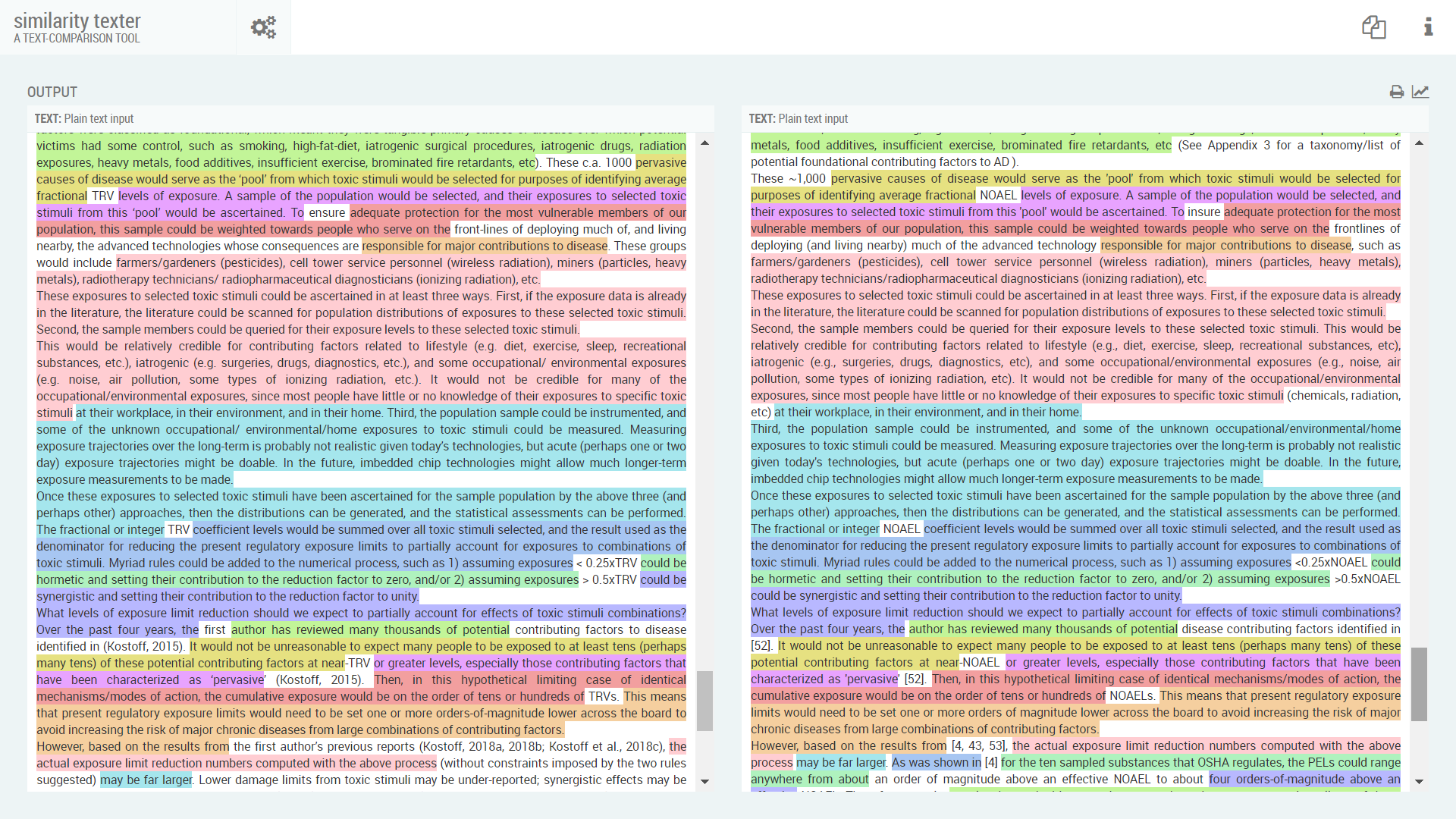
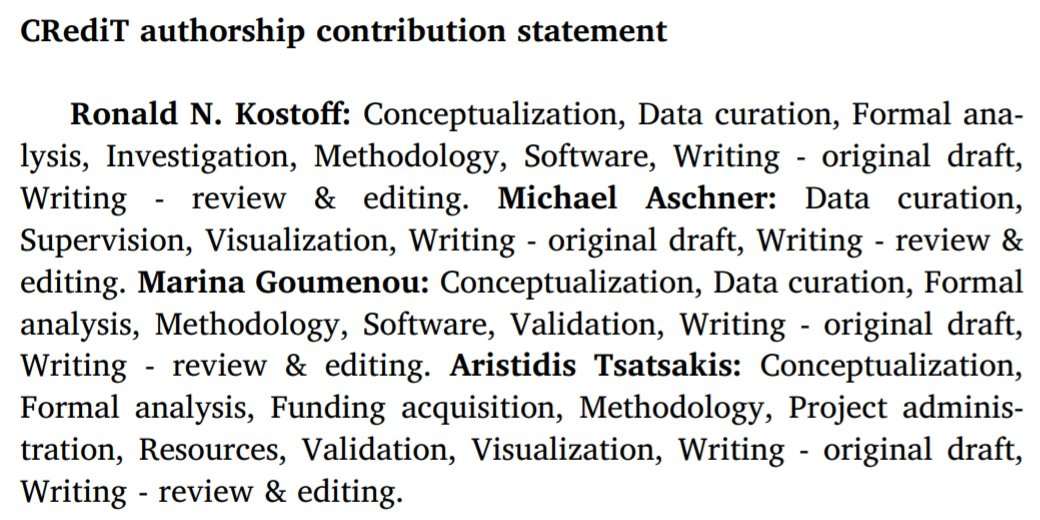 Anyway, when the piece appeared in Elsevier’s Food & Chem. Tox., it benefited from general sentence-level tweaking, while a brief place-holder section on “Proposed Regulatory Modification” was fleshed out. The arrival of Aschner and the University of Crete research fellow Marina Goumenou and Tsatsakis quadrupled the size of the authorship list. Curiously, all four shared credit for writing Kostoff’s draft. Goumenou and Tsatsakis had Conceptualized it. Aschner had Supervised it, Visualized, and Curated the Data. Tsatsakis claimed credit for everything, including Funding Acquisition and Project Administration.
Anyway, when the piece appeared in Elsevier’s Food & Chem. Tox., it benefited from general sentence-level tweaking, while a brief place-holder section on “Proposed Regulatory Modification” was fleshed out. The arrival of Aschner and the University of Crete research fellow Marina Goumenou and Tsatsakis quadrupled the size of the authorship list. Curiously, all four shared credit for writing Kostoff’s draft. Goumenou and Tsatsakis had Conceptualized it. Aschner had Supervised it, Visualized, and Curated the Data. Tsatsakis claimed credit for everything, including Funding Acquisition and Project Administration.
My punctilious concern for fairness compels me to note that Toxicology Reports is not the only publication outlet for this circle. Journals from the Spandidos stable are also available, with many papers channeled through International Journal of Molecular Medicine, collecting Spandidos along the way as honorary co-author. There is so much inbreeding in the references of these papers, they all have hemophilia.
- Ronald N. Kostoff, Michael B. Briggs, Alan L. Porter, Demetrios A. Spandidos, Aristidis Tsatsakis [Comment] COVID‑19 vaccine safety Int J Mol Medicine (2020) doi: 10.3892/ijmm.2020.4733. Twenty-four out of 42 citations are to the seminal contributions of A. Tsatsakis.
- Daniela Calina , Anca Oana Docea , Demetrios Petrakis , Alex M Egorov , Aydar A Ishmukhametov , Alexsandr G Gabibov , Michael I Shtilman , Ronald Kostoff , Felix Carvalho , Marco Vinceti , Demetrios A Spandidos , Aristidis Tsatsakis Towards effective COVID‑19 vaccines: Updates, perspectives and challenges (Review) IInt J Mol Medicine (2020) doi: 10.3892/ijmm.2020.4596
- Ronald N Kostoff , Michael B Briggs , Alan L Porter , Michael Aschner , Demetrios A Spandidos , Aristidis Tsatsakis [Editorial] COVID‑19: Post‑lockdown guidelines Int J Mol Medicine (2020) doi: 10.3892/ijmm.2020.4640

Tobacco Marketing Journal
Progressing deeper into the dramatis personae, we have already met Dr Konstantinos Poulas of University of Patras, another Tsatsakis stunt-double editor. Poulas’ point of difference is his moonlighting for the tobacco industry: he is funded to promote vaping and patches as the golden path to cigarette cessation (i.e. continued nicotine addiction), and to find new applications for them. See:
- https://tobaccotactics.org/wiki/nosmoke-institute/
- Stéphane Horel, Ties Keyzer Covid 19: How harm reduction advocates and the tobacco industry capitalised on the pandemic to promote nicotine The BMJ (2021) DOI: 10.1136/bmj.n1303
Leonid wrote earlier about the Parisian professors Jean-Pierre Changeux and Zahir Amoura, and their discovery of nicotine as a COVID-19 cure or prophylactic.
[I exchanged many emails with Changeux, and was informed that a) Amoura is currently running a COVID-19 clinical trial with nicotine patches, and b) Changeux is into ivermectin as COVID-19 cure now because he once showed this antiparasitic binds to the nicotine receptor. -LS]
I am obliged by scrupulous fairmindedness to note that priority belongs with this preprint on the Qeios server:
Konstantinos Farsalinos, Raymond Niaura, Konstantinos Poulas COVID-19, a disease of the nicotinic cholinergic system? Nicotine may be protective Queios (2020) doi: 10.32388/JFLAE3.2
Those authors were first to recognise the nicotine-promotion opportunities of the present pandemic, as they pointed out themselves.
“We emphasize that researchers should be cautious when presenting previously-published (or pre-published) work as their own “novel” work. Copying methodologies and reporting previously-presented hypotheses without citing the original authors, especially when publication and pre-publication dates are documented, can be considered plagiarism and a breach of intellectual property copyright.”
 One of those Toxicology Reports Special-Issue papers makes more sense in this context:
One of those Toxicology Reports Special-Issue papers makes more sense in this context:
Nikolaos Alexandris , George Lagoumintzis , Christos T. Chasapis , Demetres D. Leonidas , Georgios E. Papadopoulos , Socrates J. Tzartos , Aristidis Tsatsakis , Elias Eliopoulos , Konstantinos Poulas , Konstantinos Farsalinos Nicotinic cholinergic system and COVID-19: In silico evaluation of nicotinic acetylcholine receptor agonists as potential therapeutic interventions Toxicology Reports (2021) doi: 10.1016/j.toxrep.2020.12.013
The results had already appeared in a MDPI journal but were important enough to recycle:
Konstantinos Farsalinos , Elias Eliopoulos , Demetres Leonidas , Georgios Papadopoulos , Socrates Tzartos , Konstantinos Poulas Nicotinic Cholinergic System and COVID-19: In Silico Identification of an Interaction between SARS-CoV-2 and Nicotinic Receptors with Potential Therapeutic Targeting Implications International Journal of Molecular Sciences (2020) doi: 10.3390/ijms21165807
A collaborative Editorial makes more sense too:
Konstantinos Farsalinos, Raymond Niaura , Jacques Le Houezec , Anastasia Barbouni , Aristidis Tsatsakis , Dimitrios Kouretas , Apostolos Vantarakis , Konstantinos Poulas Editorial: Nicotine and SARS-CoV-2: COVID-19 may be a disease of the nicotinic cholinergic system Toxicology Reports (2020) doi: 10.1016/j.toxrep.2020.04.012
This introduced a Special Issue on “Novel nicotine-delivering products: toxicology, regulation and health issues” (Eds. Tsatsakis, Kouretas & Poulas). Toxicology Reports has become a Tobacco Marketing journal. I hope that Elsevier management enjoy life’s little ironies. Our authors consistently insist that they “report no declarations of interest.”
It turns out that the European Respiratory Journal imposes less flexible ethical expectations on its contributors. Another Poulas / Farsalinos paper was retracted for their failure to disclose their funding sources as a potential Conflict of Interest.
Giannouchos TV, Sussman RA, Mier Jé M, Poulas K, Farsalinas K. Characteristics and risk factors for COVID-19 diagnosis and adverse outcomes in Mexico: an analysis of 89,756 laboratory–confirmed COVID-19 cases. Eur Respir J (2020) doi: 10.1183/13993003.02144-2020
That paper, now completely deleted, once proclaimed:
“Current smoking was not associated with adverse outcome.”
In detail:
“Notably, smoking was not associated with a higher risk for adverse outcomes and hospitalization. Smokers were also less likely to be diagnosed with COVID-19 compared to non-smokers.

Farsalinos is another of the Toxicology Reports editorial circle. He is not accused of receiving tobacco funding, and does not need its motivation. In fact this curious notion that nicotine is a sovereign remedy for COVID-19 began as his PhD topic. Farsalinos was already an advocate of vaping as a nicotine-delivery cigarette substitute, to the point of evangelism, as a guru for the cause. His antipathy of suggestions that vaping might have its own health hazards extends as far as spearheading campaigns demanding the retraction of vaping-hazard papers (“It’s only censorship when it happens to me“).
But I should credit RetractionWatch explicitly and not just provide links:
(5) Researchers call for retraction of NEJM paper showing dangers of e-cigarettes
To continue with the scrupulous fairness, Poulas is not only a wholly-owned subsidiary of the tobacco industry, and the time he can spare from promoting nicotine to cure COVID-19, he devotes to the deprecation of COVID-19 vaccines. After the retraction of Walach’s paper-shaped hairball from Vaccines, Poulas took to Faceborg to express his anger, warning the hairball’s critics that if struck down, it should become more powerful than they can possibly imagine:

“Retraction of the article, at the speed it took, raises questions. The authors disagree. We will soon see it published in another journal. It will also remain there forever, to haunt the Editors. The methodology is correct and the conclusions justified. For the record, he also reacted to an Associate editor from the oxford vaccine group. That is, from the group that published in Lancet three papers for their vaccine. The battle has just begun. Other episodes will follow.“
As noted, the paper was successfully rehomed at the Institute of Pure and Applied Knowledge.
An accompanying series of rage-tweets invoked the work of Farsalinos as vindication for Walach et al… as did the anonymous Reviewer #2, who had recommended the hairball for publication, praising it in glowing terms barely short of idolatry. It seems that Poulas and Reviewer #2 were the same person. Who put him forward as a reviewer?
Reviewer 2 Report
“The manuscript by Walach et al is very important and should be published urgently. Please update the data about the number of vaccinations in EU. Please avoid the use of the names “Pfizer”, “Moderna” etc and prefer the official names of the vaccines.
The authors are describing literature about the potential toxic effect of SPIKE. Please add the reference by Farsalinos et al, IJMS (https://www.mdpi.com/1422-0067/21/16/5807) describing the snake toxin-like epitope of the SPIKE protein and discuss it.”
Genital Warts
It turns out that nicotine is not the only COVID-19 cure, though, for SARS-CoV-2 is the weakest virus ever, and practically everything destroys it; it falls apart if you glare harshly at it. Poulas has written about saltwater nose-douching. Has anyone tested Incense of Bad Decisions? Then there is Imiquimod, an ointment against genital warts, which convinced Poulas and Farsalinos so much with its curative properties that they published the same report twice, in journals from Elsevier and Frontiers.
- Angelopoulou, Alexandris, Konstantinou, Mesiakaris, Zanidis, Farsalinos & Poulas Imiquimod – A toll like receptor 7 agonist – Is an ideal option for management of COVID 19 Envir Research (2020) doi: 10.1016/j.envres.2020.109858
- Poulas, Farsalinos & Zanidis Activation of TLR7 and Innate Immunity as an Efficient Method Against COVID-19 Pandemic: Imiquimod as a Potential Therapy Front. Immunol., (2020) doi: 10.3389/fimmu.2020.01373
As reliable alternatives to the boring medical mainstream, and proponents of interestingly different alternative treatments, Poulas and Farsalinos are naturally popular with the Greek media. But there is a political angle, for they are both committed to conspiracies and broader COVIDiocy, and along with Tsatsakis they are founders of DIDEADY (the Greek counterpart of the “Great Barrington Declaration“). Their denunciations of any working method of mitigating the pandemic are a better fit to some news sources than others, and they’re regular guests on (for instance) ‘ALERT TV’ – a channel owned by Kyriatos Velopoulas. But I am well out of my depth in Greek domestic politics (and international sources of funding), so all that must await someone better-qualified to comment.
Further exploration reveals Poulas as a co-author of a curious document. It is a manifesto of sorts for the Hellenic Network (this being an inchoate coalition of antivaxxers, conspiracists and fascism-friendly far-right nationalists, but I repeat myself). One might compare it to the German Querdenker. The purpose of the document is evidently to provide a pre-packaged Scientific Consensus, so that when public-facing professionals face job termination for their refusal to get vaccinated, their lawyers can brandish it in the course of the inevitable lawsuit. Also, vexatious litigation against vaccination proponents. Appendices include the text of Walach, Klement & Aukema (2021), to bring this narrative back to the beginning and to ensure that courts take the dossier seriously.
Google Translate informs me that the text is a conglomerate of the more extreme antivax brainfarts and mendacities, with the Apocalypse filter turned up to 11, as if John of Patmos wrote a sequel to ‘Revelation’ while smoking datura and DMT as well as his usual diet of special mushrooms. The spike-protein toxicity and prion disease shall take one third of the race of men, and women shall be barren as with a murrain. Then the delayed ADE shall cull a third of those who remain. And a rough beast shall rise from the abyss, with the haunches of an aardvark and the head of Bill Gates; and there shall be great tribulation for those of Science who remain steadfast and reject the Jab of the Beast.
I may have exaggerated slightly, but there is a clarion call for True Scientists to rise up against gubblement tyranny in vaccine opposition or be forever branded as traitors and apostates. I am not sure what a Clarion is but I imagine it as an adult-size version of a clarinet. The main point is that Poulas is completely bonkers.
Highly Cited Researchers
Utilities like dimension.ai and Google Scholar make it easy to tabulate the closeness of any pair of authors, in terms of how many papers they co-authored on a given topic. A colleague has helpfully plotted these as maps, or networks if you like, though the word ‘network’ can carry connotations of central organisation, and a unity of purpose – which may not the case here, where we’ve seen diversity of opinion and motivation. As with any co-authorship ‘network’, what emerges is an accretion of a series of coalitions of convenience, where authors might agree on different points within each coalition, though there is usually consensus on “We need to publish more”.

Fourteen of Kostoff’s most recent 17 papers appeared in Tsatsakis journals, acquiring Tsatsakis as a co-author along the way, so the “Kostoff” and “Tsatsakis” nodes are close. Subclusters stand out, emphasised by colors: Greece-based authors in red, Romanian authors in orange, for instance. The map is extensible, merging at its edges with the broader academic Antisocial Network. In fact any edge is artificial (just as with writing this post). Though it is best to stop before the spiderweb of threads connecting Post-It notes has outgrown a wall of your basement, and people at parties tend to edge away nervously when you try to explain what you’re up to. So the map sticks to the neighbourhood of Toxicology Reports.
Here are some Associate Editors, to put faces to the names.

There is no broader principle or lesson here, except that academic publishing is like any other aspect of academic existence. If someone obtains a position of influence, and sets about misusing it for the benefit of cronies or personal objectives, there is no ‘immune system’ or processes in place to stop them, as long as they target enough of that misuse to maintaining the metrics that keep them in a position of influence.
Also, citations indices correlate with networking and self-citation, but not at all with research quality.
In other news, one can only speculate why MDPI changed their minds about publishing a Special Issue on “SARS-CoV Spike Glycoprotein: Structure and Function“, with Doctors Poulas, Farsalinos and George Lagoumintzis as Editors (closing date for 30 November 2021), for they provided no explanation when they wished it into the cornfield. The link now points to 404.
[I should mention that Tsatsakis’ predecessor as Editor-in-Chief and the founder of Toxicology Reports, Lawrence Lash (professor at Wayne State University, USA), is a special character himself. There seems to be a system behind Elsevier’s editor recruitment, and even I am a bit surprised about their selection criteria. Elsevier never replied to any of my emails. After all, cashing in on death and suffering was also the mothership’s business back when Reed Elsevier (RELX) sold arms. -LS]

Donate to Smut Clyde!
If you liked Smut Clyde’s work, you can leave here a small tip of 10 NZD (USD 7). Or several of small tips, just increase the amount as you like (2x=NZD 20; 5x=NZD 50). Your donation will go straight to Smut Clyde’s beer fund.
NZ$10.00




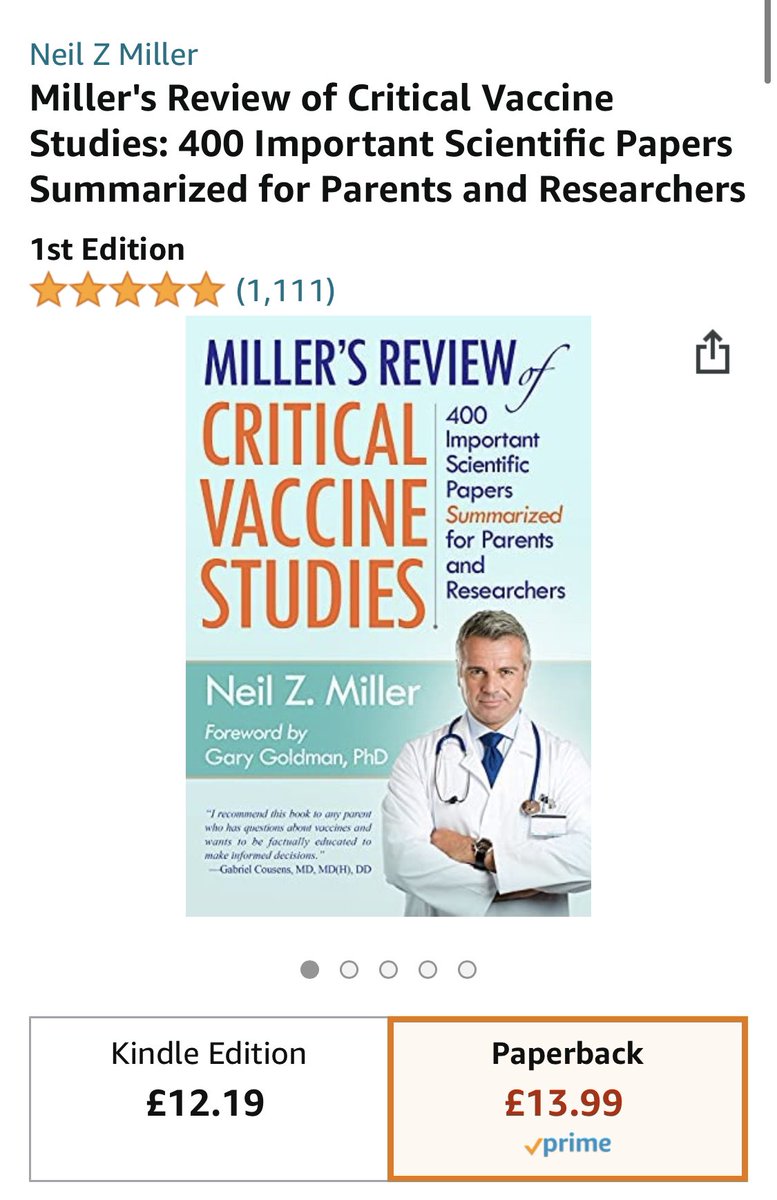







Rebranding the journal title “Toxicology Reports” with “Toxic Reports” would be mandatory.
LikeLiked by 1 person
“Aristidis Tsatsakis, Professor of Toxicology at the University of Crete, spoke about his distinction for the second consecutive year as a Highly Cited Researcher from Clarivate Analytics, today, Monday, November 22, on the radio station 98.4.”
Tsatsakis has the biggest thingy of all Greek men.
LikeLike
I’m no expert in Greek thingies, but Theodore Simos would likely disagree with you.
LikeLike
According to Raoult, our civilization is collapsing and the proof is that people are against Raoult. I am not exaggerating, that’s literally the title of his video. I sum up hereafter some of the points he makes in his video.
Of course he praizes Brazil
There is a correlation between the decrease of scientist stars (alpha males) and the increase in the number of covid death.
France has regressed a lot since the XIXth century (indeed, it was easier to be highly cited when you had colonized half of the world and could do whatever you wanted in tropical colonies)
Raoult judiciary problems are a sign of civilizationnal collapse.
And people are jealous, they want to suppress chloroquine, and doing so they suppress Raoult
LikeLiked by 1 person
Hahaha!
If Raoult weren’t what he really is – a threat to public health and to the reputation of science and medicine – he would be one of the greatest stand-up comedians since the days of Stan Laurel and Oliver Hardy.
LikeLike
Sam Klein covered all this in a Twitterthread:
LikeLike
Pingback: Come farsi la réclame – ocasapiens
Pingback: De linke weekendbijlage (48-2021) - Kloptdatwel?
So Konstantinos Poulas was denied the tenured Professorship at Patras University that he was expecting.
https://insidestory.gr/article/o-kathigitis-toy-panepistimioy-patron-poy-stirizei-toys-arnites-toy-emvolioy-gia-ton
The journalist leans over backwards to give Poulas a platform, letting him present himself as a saver of lives with his wart-cream suppository treatment for COVID, and as a victim of persecution. The gist of it, anyway (with the caveat that I am relying on G**gle Translate) is that the retraction of Poulas’ pro-vaping paper, and Elsevier’s investigation of the Special Issue of Toxicology Reports, gave the University administrators an excuse not to confer the permanent position that Poulas would otherwise be entitled to.
So ultimately it was your fault, Mr Schneider.
LikeLike
Pingback: Longwei Yin corrections, or what’s the point anyway – For Better Science
Pingback: Elsevier pandemic profiteering, again – For Better Science
Pingback: Oroscopo epidemiologico – ocasapiens
Pingback: Lex Bouter, King of Research Integrity – For Better Science
Pingback: Lashing out at Toxicology Reports – For Better Science